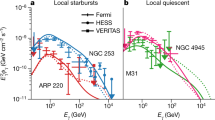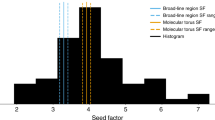Abstract
EARLY surveys of the soft X-ray diffuse background revealed an overall decrease of ∼250 eV intensity from the galactic pole to the galactic plane1−5. The effect was attributed to absorption by interstellar gas and it was widely accepted that a substantial fraction of the flux originated from beyond the galactic disk. But the detection of emission from the plane of the Galaxy2,3 (unit optical depth ∼200 pc) and from the vicinity of a radio continuum feature, the North Polar Spur6,7, demonstrated that at least part of the flux is galactic in origin. Recent surveys8,9 provide greater sensitivity and reliability. The ∼250eV results have been combined in Fig. 1. From these data it has been shown that several regions of enhanced emission are associated with radio continuum or Hα features, and that there is no simple quantitative relationship between the soft X-ray intensity and 21-cm values of neutral hydrogen column density. It has been concluded on this basis that most if not all of the flux is generated within the Galaxy (refs 8, 9 and A. N. Bunner, unpublished). Since stellar sources or diffuse non-thermal processes cannot easily account for the observed intensity8,10, thermal bremsstrahlung from a hot gas is now accepted as the most probable source mechanism. The discovery of a shallow OVI absorption line in the spectra of many nearby stars supports this hypothesis11−13.
This is a preview of subscription content, access via your institution
Access options
Subscribe to this journal
Receive 51 print issues and online access
$199.00 per year
only $3.90 per issue
Buy this article
- Purchase on Springer Link
- Instant access to full article PDF
Prices may be subject to local taxes which are calculated during checkout
Similar content being viewed by others
References
Bowyer, C. S., Field, G. B., and Mack, J. E., Nature, 217, 32 (1968).
Henry, R. C., Fritz, G., Meekins, J. F., Friedman, H., and Byram, E. T., Astrophys. J. Lett., 153, L11 (1968).
Bunner, A. N., et al., Nature, 223, 1222 (1969).
Kato, T., Astrophys. Space Sci., 16, 478 (1972).
Davidsen, A., et al., Astrophys. J., 177, 629 (1972).
Bunner, A. N., Coleman, P. L., Kraushaar, W. L., and McCammon, D., Astrophys. J. Lett., 172, L67 (1972).
De Korte, P. A. J., Bleeker, J. A. M., Deerenberg, A. J. M., Tanaka, Y., and Yamashita, K., Astrophys. J. Lett., 190, L5 (1974).
Williamson, F. O., et al., Astrophys. J. Lett., 193, L133 (1974).
De Korte, P. A. J., thesis, Univ. Leiden (1975).
Vanderhill, M. J., Borken, R. J., Bunner, A. N., Burstein, P. H., and Kraushaar, W. L., Astrophys. J. Lett. (in the press).
York, D. G., Astrophys. J. Lett., 193, L127 (1974).
Jenkins, E. B., and Meloy, D. A., Astrophys. J. Lett., 193, L121 (1974).
Kraushaar, W. L., Astrophys. J. (in the press),
Gould, B. A., Uranometria Argentina, 335 (1879).
Shapley, H., Astrophys. J., 49, 311 (1919).
Hubble, E., Astrophys. J., 56, 162 (1922).
Davies, R. D., Mon. Mot. R. astr. Soc., 120, 483 (1960).
Goldstein, S. J., and MacDonald, Delphine, D., Astrophys. J., 157, 1101 (1969).
Fejes, I., and Wesselius, P. R., Astr. Astrophys., 24, 1 (1973).
Reynolds, R. J., Roesler, F. L., and Scherb, F., Astrophys. J. Lett., 192, L53 (1974).
Hayakawa, S., et al., Astrophys. J., 195, 535 (1975).
Berkhuijsen, Elly M., Haslam, C. G. T., and Salter, C. J., Astr. Astrophys., 14, 252 (1971).
Cox, D. P., and Smith, B. W., Astrophys. J. Lett., 189, L105 (1974).
Spoelstra, T. A. TH., Astr. Astrophys., 21, 61 (1972).
Spoelstra, T. A. TH., Astr. Astrophys., 24, 149 (1973).
Brown, R. L., and Gould, R. J., Phys. Rev. D., 1, 2252 (1970).
Berkhuijsen, Elly M., Astr. Astrophys., 14, 359 (1971).
Author information
Authors and Affiliations
Rights and permissions
About this article
Cite this article
RAPLEY, C. Absorption of soft X rays by material within Gould's Belt. Nature 255, 41–42 (1975). https://doi.org/10.1038/255041a0
Received:
Accepted:
Issue Date:
DOI: https://doi.org/10.1038/255041a0
Comments
By submitting a comment you agree to abide by our Terms and Community Guidelines. If you find something abusive or that does not comply with our terms or guidelines please flag it as inappropriate.



